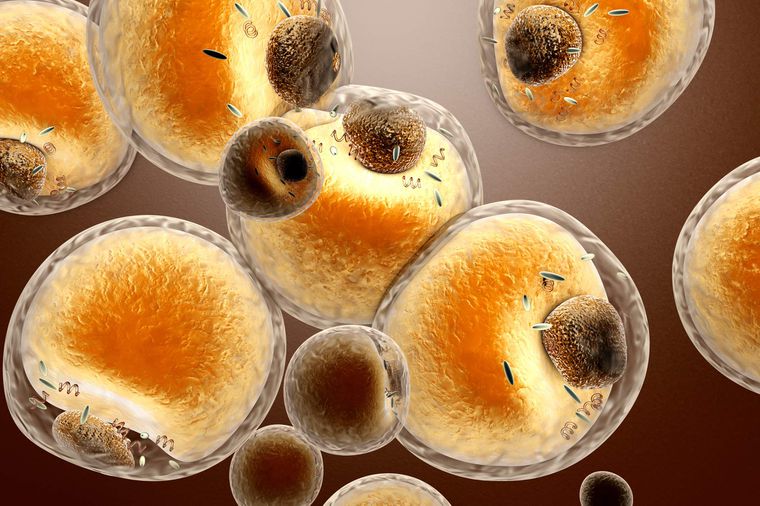Fats: The Various Types Of Fat Cells In The Body And How To Optimize Them For Weight Loss And Better Health
Source: Fats May 19, 2020 5 years, 7 months, 3 weeks, 3 days, 22 hours, 14 minutes ago
Fats: Unknown to many, there are three distinct types of fat cells in the human body and understanding what they are and their properties could help us manage our weights and also our health. We all know that carrying excess fat is bad as it can lead to a number of chronic disease including diabetes, cardiovascular problems and also kidney disease. It is important to understand that not all fat cell types are the same.

Although certain types of fat cells can accumulate in our bodies and cause health problems, other types have evolved to turn fuel into heat so they can actually burn calories and provide us with energy.
New research even shows that having higher concentrations of "good" fat cells in our bodies can help us burn more calories when we're exposed to cold temperatures or to other conditions.
https://academic.oup.com/jcem/advance-article-abstract/doi/10.1210/clinem/dgaa183/5825408?redirectedFrom=fulltext
The concept of different "coloured" fats ie brown, white and beige often comes up in fad diets encouraging one to eat special foods for weight loss without much proof they work. But understanding the science behind these different types of fat cells and how to transform one type into another really could be an important way to keep healthy, and even treat serious conditions such as obesity.
Typically, white fat cells are found in the body's connective tissues, usually beneath the skin (subcutaneous fat) and in the abdominal cavity (visceral fat).
Upon consuming food, the white fat cells primarily convert excess energy in the form of glucose that it does not need into lipid droplets, usually as molecules called triglycerides. These produce signaling molecules that regulate appetite and energy balance.
https://www.nature.com/articles/s41580-018-0085-z and
https://www.sciencedirect.com/topics/biochemistry-genetics-and-molecular-biology/triacylglycerol and
https://www.sciencedirect.com/topics/medicine-and-dentistry/homeostasis
On the other hand, Brown fat cells were mistakenly believed to be found only in newborn babies and would disappear in infancy. Later, research showed that brown fat cells exist in the body throughout your life.
https://www.ncbi.nlm.nih.gov/pmc/articles/PMC5206678/
We Need Your Help. Please Help To Sustain This Website And All Our Initiatives To Propel Research By Donating. https://www.thailandmedical.news/
p/sponsorship
Often, brown fat cells are located in regions between the shoulder blades, neck, along the spinal cord, and above the collarbone. But they can emerge in other parts of the body such as around the vital organs, where they turn food into heat.
https://www.ncbi.nlm.nih.gov/pmc/articles/PMC3661606/ and
https://www.ncbi.nlm.nih.gov/pmc/articles/PMC3661606/
Interestingly research has found a third type of fat cells, called beige or "brite" (brown in white) fat cells. These cells act like brown fat cells, but are found in similar areas as white fat cells.
https://www.ncbi.nlm.nih.gov/pubmed/23782940
It was found that beige fat cells are derived from white fat in a process called "browning" which is triggered by exposure to low temperatures, typically 3°C above a person's shivering temperature point, which is around 11°C for women and around 9°C for men.
https://www.nature.com/articles/s41598-019-49936-x and
https://www.sciencedirect.com/science/article/pii/S0306456518301918
Also other stimuli such as good nutrition and exercise are also believed to encourage the browning process.
https://www.ncbi.nlm.nih.gov/pubmed/29102386 and
https://www.sciencedirect.com/science/article/pii/S0026049517303219
The white fat cells are typically round cells of variable sizes with a single, large, lipid droplet. These droplets can be converted to fatty acids during starvation or when energy demands increase. Fatty acids are the building blocks of fats which can be absorbed into the blood.
However brown fat cells are smaller, and have many small lipid droplets per cell. Brown fat cells also contain many energy generating organelles called mitochondria. These are rich in iron, which give them their brown colour when exposed to oxygen.
On the other hand, beige fat cells have features midway between white and brown. They come from white parent cells, but function like brown fat cells by burning energy to produce heat when the core body temperature dips. The browning process is helped by cold temperatures, and the nervous and immune systems.
https://www.ncbi.nlm.nih.gov/pmc/articles/PMC4435534/ and
https://stm.sciencemag.org/content/11/495/eaax9559
White fat cells can acquire the characteristics of brown fat cells under certain conditions, such as low temperatures and certain proteins. But researchers now know that all types of fat cells can change from one form to another depending on what triggers they're exposed to and the demands placed on the organism they're found in.
https://link.springer.com/article/10.1007/s13105-018-0658-5 and
https://www.ncbi.nlm.nih.gov/pmc/articles/PMC4663373/
It is known that a fat cell can only change into another form one of two ways. It can switch its corresponding genes in a process known as transdifferentiation. Or, the change can be achieved by reverting any mature fat cells to their common parental form (dedifferentiation), then "reprogramming" their genes (redifferentiation). This second process can happen naturally, but is usually achieved in lab settings.
https://www.researchgate.net/publication/10967311_Adipocyte_differentiation_and_transdifferentiation_Plasticity_of_the_adipose_organ and
https://www.ncbi.nlm.nih.gov/pmc/articles/PMC3756103/
Interestingly the conditions for natural change can also be sped up. Nutritional supplements, such as the flavonoids resveratrol and quercetin, which are found in fruits and vegetables, can help the browning process. Exercise has also been shown to increase browning.
https://onlinelibrary.wiley.com/doi/full/10.1002/oby.21706 and
https://www.ncbi.nlm.nih.gov/pubmed/29155135
It is also known that exposure to temperatures slightly above the shivering point for at least two hours is also known to help with browning. However, this needs to be practiced regularly to see any real changes.
https://www.ncbi.nlm.nih.gov/pmc/articles/PMC6466122/
Research studies also show that brown fat cells are associated with better health. They encourage weight loss, which may subsequently reduce obesity and other related diseases caused by excess weight.
https://www.ncbi.nlm.nih.gov/pmc/articles/PMC2699856/
Also, brown fat cells reduce the risk of hypothermia and can reduce the risk of diabetes by increasing insulin sensitivity. The ability to cause the browning of white fat cells and turn them into beige cells therefore brings the potential for better health.
https://www.cell.com/trends/endocrinology-metabolism/fulltext/S1043-2760(15)00046-6
For more articles about
Fats and weight loss, keep on logging to Thailand Medical News.
We Need Your Help. Please Help To Sustain This Website And All Our Initiatives To Propel Research By Donating. https://www.thailandmedical.news/p/sponsorship
